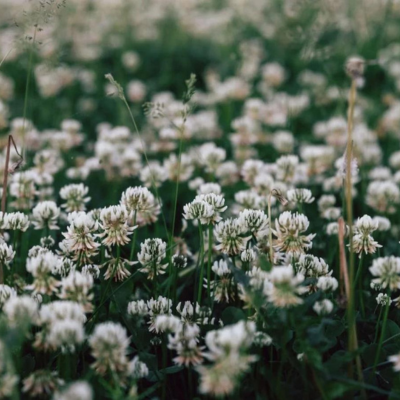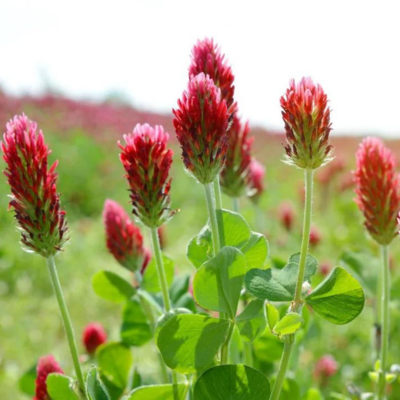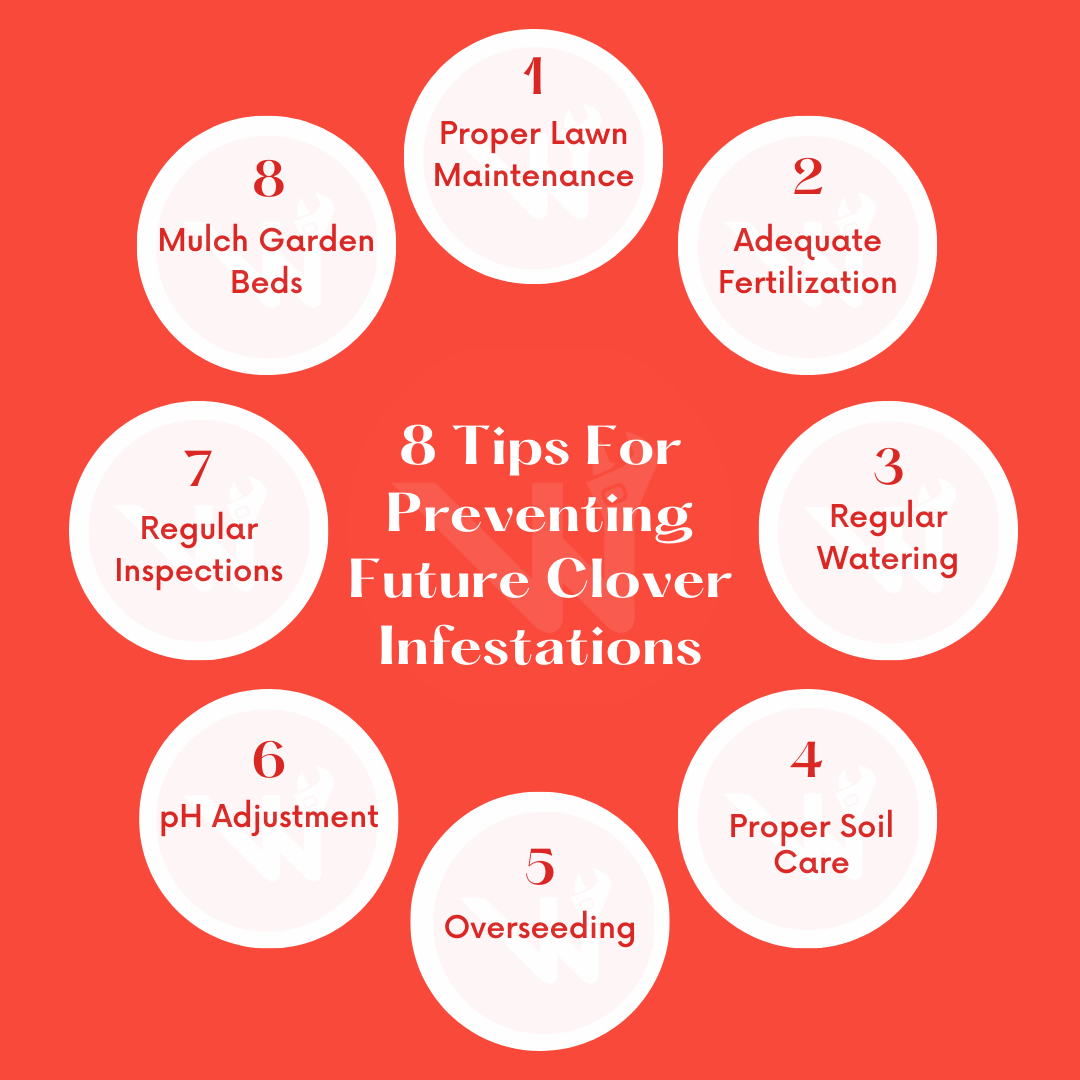You must be wondering how to get rid of clover from your lawn?
Clover infestations in lawns present a common challenge for homeowners trying to maintain their lawn health and seeking lush, vibrant green spaces. While clover is a hardy plant with nitrogen-fixing properties that benefit the soil, its presence can be unwelcome due to its distinct appearance, which disrupts the uniformity of the lawn.
Understanding the challenge of clover in your lawn is the first step to green lawn maintenance.
Let us walk you through a step-by-step guide that will help you in this process.
White clover (Trifolium repens) and red clover (Trifolium pratense) are two of the most abundant clover species, typical lawn weed types.
Here is how you can undertake the process of recognizing the clover varieties in your yard:


Recognizing different clover species in your law will require you to pay attention to the leaflet form, the presence of the white or red spots, and the size of the plant to correctly identify these clover species in your lawn.
The presence of clover, a typical lawn plant, can be used to gauge the health of your grass because it is one of the many lawn health indicators. Clovers may appear in lawns for several reasons, let us walk you through some clover growth triggers:
Commonly, clover flourishes on lawns with particular types of soil qualities:
Clover is a good indicator of the general health of your lawn, as shown by these facts:
- Nitrogen Fixation: Although clover competes with grass for nutrients, supplying the soil with nitrogen improves the lawn's health.
- Drought Resistance: Clover is more drought-resistant than certain grasses because of its thick root structure.
- Mowing and upkeep: Mowing lawns too short or too often will stress grasses and leave spaces for clover to grow. Clover development can be slowed down by modifying your mowing procedures.
Regular care procedures can help prevent clover growth while enhancing the general health of your grass, such as appropriate mowing and irrigation. You can create a lush, clover-free lawn by understanding the reasons behind clover growth in lawns.
Manually removing clover for lawn restoration can effectively combat small infestations and even manage larger ones. Here are techniques of clover eradication for both scenarios:
Using herbicides to control clover in your lawn is an effective method. Here's a discussion of chemical options, along with safety guidelines and application tips of clover eradication products:
While herbicides might be useful weed killers, it's important to keep in mind that they should only be applied as a part of a comprehensive lawn care strategy.
Clover can also be avoided by maintaining good lawn care practices, such as regular mowing, watering, and fertilizing.
Eliminating clover from your lawn using natural and organic methods is an environmentally friendly lawn care approach that can promote a healthy, chemical-free lawn. Here are several strategies and cultural practices to consider:
Hand Pulling: The simplest method is hand pulling. Check your lawn frequently, and remove any clover plants by hand, pulling up the entire root system. This works well for minor infestations.
Vinegar and Soap Spray: Mix white vinegar, liquid dish soap, and water to make a natural herbicide. Spray this solution straight onto clover patches, taking care not to get any on your lawn in the process.
Overseeding: Increase the amount of grass seed in your lawn by overseeding. A thick, lush lawn can beat Clover back. Pick grass varieties appropriate for your area's soil and climate.
Corn Gluten Meal: Clover seed germination can be inhibited by using corn gluten meal, a natural pre-emergent herbicide. Before clover seeds have a chance to sprout, apply it in the spring.
Clover-Specific Herbicides: Some organic herbicides kill broadleaf weeds like clover without damaging grass. Shop for items that have iron HEDTA or ammonium nominated as active components.
Mow High: Mow high to keep your grass at a greater height. Taller grass blocks out clover and hinders its growth. The mower height should be set at roughly 3 inches.
Aerating and Dethatching: Aerating the soil and dethatching your grass can increase its health and make it less conducive to clover growth. This improves your grass's ability to absorb nutrients and water.
Fertilize and Lime: If your soil is excessively acidic, use lime to maintain the right pH balance in your grass. Fertilize your lawn to promote growth and overall health so that it will be more resilient to clover infestations.
By adopting these alternative clover control methods that are natural and organic, you can reduce or even eliminate clover in your lawn while promoting a sustainable and eco-friendly approach to lawn care.
Engaging experts to remove clover from your lawn offers vital advantages in both efficiency and effectiveness. Clover infestations can be challenging to tackle alone, and professionals bring critical attributes to the task.
Specialized Knowledge: Lawn care professionals have a specialized understanding of the different types of clover and how to deal with them.
Efficiency: Professionals have access to high-quality tools, herbicides, and techniques that expedite clover removal. This can save you time and ensure more thorough results.
Safety and Environmental Considerations: Professionals use chemicals and herbicides responsibly, causing the least amount of harm to your lawn and the ecosystem around it.
Time Savings: Taking out clover requires a lot of labor. You have more time for other responsibilities when you hire specialists.
Guaranteed Results: Many reputable lawn care companies provide guarantees, giving you peace of mind that your clover problem will be treated.
By hiring professionals, you help maintain the long-term health and beauty of your lawn in addition to ensuring the effectiveness of clover removal. Professional lawn care services are a good investment for homeowners because of their competence and effectiveness.

Preventing clover from returning to your lawn requires a proactive approach to lawn care. Here are some lawn maintenance tips and strategies for keeping clover at bay in your lawn:
Maintain your lawn properly by cutting it at the recommended height for the type of grass you have, usually around 3 inches. A properly mowed lawn makes it difficult for clover to grow.
The application of a balanced fertilizer will guarantee that your grass receives the nutrients to outcompete clover and keep it from growing again.
It's best to water your grass early in the morning, deeply, and infrequently strengthening its defenses against clover and other weeds.
Aerate your lawn to promote soil structure and drainage for proper soil care. The foundation of a robust, clover-resistant lawn is healthy soil.
Using premium grass seed to overseed your lawn will increase the grass cover and reduce open spots where clover can grow.
Maintaining the proper pH balance can inhibit the growth of clover because it can thrive in slightly acidic soils.
Check your grass frequently for clover emergence, i you see any little patches, get rid of them right once to stop them from spreading.
Garden beds should be mulched if they are close to your lawn to establish a barrier that will stop clover from encroaching.
You must now have a better understanding of how to get rid of clover in your lawn. The key takeaways for beautiful lawn achievement involve a combination of proactive measures, such as proper mowing, fertilization, and consistent maintenance.
Enjoying a green, clover-free yard not only enhances the visual charm of your outdoor space but also provides a more comfortable and inviting environment for recreational activities, making it a rewarding endeavor for any homeowner trying to achieve a beautiful and clover-free lawn